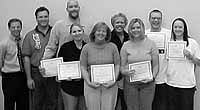| Views from the wedge overlooking the San Rafael Swell are often referred to as the Little Grand Canyon. |
The San Rafael Swell is Utah’s fastest growing tourist destination. Most of this huge area is open to the public and adventures are left only to the visitor’s imagination. The Swell is 2,000 square miles of public land, known for its scenic sandstone formations, deep canyons, desert streams, and expansive panoramas.The Swell is a massive maze of winding canyons, broken fins, and multi-hued buttes scattered in a tightly defined oblong right in the heart of Utah.
The geological wonder is located between Castle Dale, Green River, Hanksville, and the northern end of Capitol Reef National Park. It was widely unknown until the 1870’s, when Interstate 70 punched through the middle of it. Here millions of years of layered sediment was pushed up into a massive bubble, which then eroded down leaving jagged edges poking up.
Wilderness beauty awaits you in the vast open area of the San Rafael Swell. Whether visitors choose the power of this still untamed land on a bike, on foot, on horseback, by car, in a 4-wheel drive or on an ATV, the grandeur of the high cliffs, deep ravines and magnificent mountains will never leave them.
Volumes have been published about the Swell but here is a brief overview of some of the significant sights:
Areas North of 1-70:
Buckhorn Draw and San Rafael Bridge
Once the scene of outlaw chases, Buckhorn Draw, a long, steep-walled canyon, is the main northern gateway to the Swell. A canyon highlight is the interpreted Buckhorn Draw Native American rock art site. These striking figures were restored as Emery County’s Utah Centennial Project in 1996.
The Wedge Overlook
It provides a striking view of the Little Grand Canyon, the San Rafael River, and the Sid’s Mountain Wilderness Study Area. To protect the fragile resources, notably an endangered cactus species, use of motorized vehicles and mountain bikes is limited to designated roads and camping is limited to designated sites. To visit the overlook, drive from the town of Cleveland south towards the San Rafael Recreation Site. Continue beyond the Buckhorn Reservoir just over four miles to the water tank at the Buckhorn Flat Well. After passing the tank, go left at the next intersection and continue six miles to the overlook.
Cleveland-Lloyd Dinosaur Quarry
The Cleveland-Lloyd Dinosaur Quarry, a national natural landmark, is one of the world’s foremost dinosaur fossil sources. Recognized as the primary source of flesh-eating Allosaur skeletons, the site features a visitor center, guided tours, dinosaur walks, and a picnic area. The Quarry is 30 miles south of Price.
Cedar Mountain Recreation Area
Cedar Mountain towers over the northern San Rafael Swell and is ideal for getting a “bird’s eye” view. An exhibit at this cliff-top overlook summarizes area geology.
| Canyons in the San Rafael Swell offer a variety of exploring opportunities. |
Areas South of I-70:
Head of Sinbad and Swasey’s Cabin
Just off I-70, the Head of Sinbad area invites camping, hiking, and exploring. The elements have molded the buff colored sandstone into pocketed watchtowers and other fanciful shapes. Members of the Swasey family first grazed livestock in the area in the late 1800’s. Today visitors may see the log cabin they built in 1921.
Hidden Splendor
The Hidden Splendor uranium mine was famous in Utah. Originally named the Delta, it was started by Vernon Pick in 1952. He extracted a million dollars of ore before selling the mine. It closed in 1957 without reaching its estimated potential. The site of the old mine is tucked away in a canyon, at the southern end of the Swell.
Hondu Arch and Tomsich Butte
Hondu Arch is a large natural opening that rests high above Muddy Creek. The abandoned Dirty Devil uranium mines at Tomsich Butte were started by W. J. Hanret and John Tomsich in 1951. The undeveloped Hondu Arch and Tomsich Butte area is rich in opportunities for hiking, camping, mountain biking and exploring.
Goblin Valley State Park and Little Wild Horse Canyon
Goblin Valley is famous for its large collection of fancifully-shaped rock formations.
Keesle Country
Keesle Country is a maze of canyons in the southwest corner of the Swell. A short hike or horseback ride into this roadless area will provide an introduction to its primitive character.

